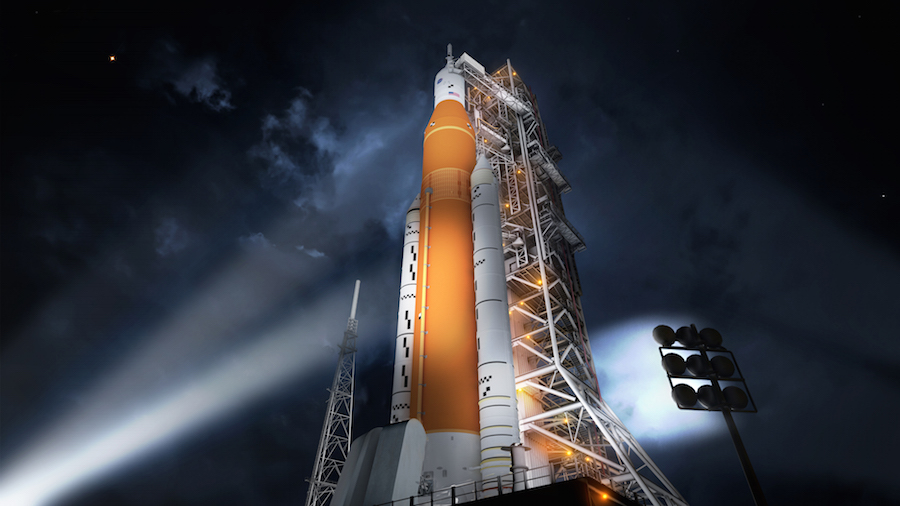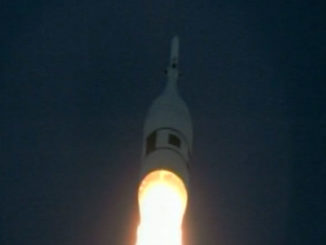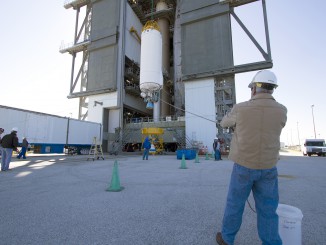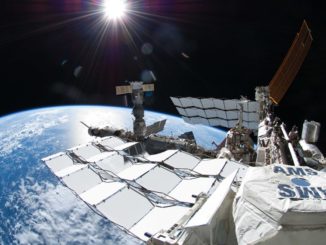
The mobile platform intended to carry NASA’s Space Launch System will trek to the mega-rocket’s launch pad at the Kennedy Space Center in Florida as soon as Thursday, before heading inside the spaceport’s huge Vehicle Assembly Building for the first time next month.
Spaceflight Now members can watch live video of the mobile launch platform’s move to the pad.
Workers at the Florida launch base have installed more than a half-dozen retractable arms, umbilical connections and support masts on the mobile launcher over the past 18 months, following a lengthy process to redesign the tower’s base to accommodate the heavy-lifting Space Launch System.
Originally built for NASA’s Ares 1 rocket, a single-booster launcher which never flew on an orbital mission before its cancellation in 2010, the mobile launch platform stands nearly 400 feet tall and weighs approximately 10.5 million pounds. After the Ares 1 rocket was canceled with NASA’s Constellation moon program in 2010, NASA decided to modify the structure for the more powerful Space Launch System, which replaced the Ares rocket family as the launch vehicle for the space agency’s ambitions for the human exploration of deep space.
The SLS will tower more than 30 stories tall, and will become the most powerful launcher in the world once it debuts. Its primary use will be to launch NASA’s Orion crew capsule, a four-person craft that will take astronauts to the vicinity of the moon, where NASA intends to construct a mini-space station in a high-altitude lunar orbit.
One of NASA’s heavy-duty crawler-transporters, a holdover from the Apollo moon program, will lift the mobile launch platform and transfer it from a park site just north of the space center’s Vehicle Assembly Building to launch pad 39B, the seaside facility where SLS missions will take off, beginning with the mega-rocket’s oft-delayed inaugural test flight in mid-2020 on an uncrewed launch.
Unlike the space shuttle’s decommissioned launch platforms, the SLS launch table includes a fixed tower complete with an elevator and connections to route propellants, purges, power and other commodities between the launch vehicle and ground supplies.

The diesel-powered transporter will move the mobile launcher along the rock-covered crawlerway originally built in the 1960s for NASA’s Saturn 5 moon rocket, then used for 30 years during the space shuttle program.
NASA’s crawler-transporter team has practiced for the move in recent weeks by transferring a shuttle-era platform up and down the crawlerway.
Bill Hill, NASA’s deputy associate administrator for exploration systems development, said Monday that the SLS platform’s journey is expected to begin around midday Thursday, likely followed by an overnight stop somewhere along the crawlerway before the trip to pad 39B concludes Friday.
The mobile launcher’s rollout to pad 39B will mark the structure’s second visit to the launch complex, following a brief trip in late 2011. But that visit occurred with the platform still in its Ares 1 configuration, and this week’s trip will be the first time the platform has trekked to pad 39B with its full complement of umbilicals, plumbing, and other equipment necessary for the SLS.
The platform is scheduled to roll back toward the Vehicle Assembly Building around Sept. 7, followed by an employee and media event at the spaceport, before the mobile launcher rolls into High Bay 3 of the cavernous assembly building around Sept. 8, according to Hill.
That will be the first time the platform will enter the VAB.
“We decided to go to the pad first,” Hill said Monday in a meeting of the NASA Advisory Council’s human exploration nd operations committee. “We’re going to do fit checks, and then if we find anything we need to fix while we’re in the VAB, we’ll have time to fix those.”
Work at the mobile launcher’s park site near the VAB over the last year-and-a-half has centered on lifting and attaching swing arms and umbilical connectors up and down the tower. The attachments included the addition of the crew access arm, a vehicle stabilizer, fueling and purge lines for the SLS and Orion spacecraft, and two large Tail Service Masts at the base of the platform to route cryogenic propellants into the SLS core stage.
See NASA’s fact sheet on the mobile launcher’s umbilical arms.

Once the mobile launch platform is inside the VAB, workers will commence an exhaustive multi-month verification and validation campaign to ensure the tower is ready to support stacking and liftoffs of the Space Launch System. The testing will include swinging the umbilical arms as they will move in the final minutes and seconds of an SLS countdown, according to a NASA spokesperson.
One swing arm that cannot be fully moved inside the VAB high bay is the crew access arm, which astronauts will use to board the Orion capsule flying atop the Space Launch System. Workers at the mobile launcher’s park site north of the VAB completed outdoor testing of the crew access arm earlier this month after its installation on the tower’s 274-foot-level in February.
Other test objectives inside the VAB include testing of the mobile launcher’s ground special power, launch release and thermal control subsystems, a NASA spokesperson said in response to questions from Spaceflight Now.
“In addition, final (mobile launcher) construction work will be completed which will include structural work,” the spokesperson said.
Since the retirement of the space shuttle in 2011, NASA has outfitted High Bay 3 — one of four VAB rocket assembly bays — with new work platforms designed for the Space Launch System.
The mobile launcher’s test campaign inside the VAB should be completed by the third quarter of 2019, Hill said.
The platform will then head back to pad 39B for more extensive testing there, before returning to the VAB for the start of stacking of the first Space Launch System.
Cranes will first stack the launcher’s twin five-segment solid rocket boosters — manufactured by Northrop Grumman Innovation Systems — followed by the lowering of the Space Launch System’s huge Boeing-built 27.6-foot-diameter (8.4-meter) hydrogen-fueled core stage between the solid-fueled motors. The core stage will be powered by four Aerojet Rocketdyne RS-25 main engines, uprated powerplants left over from the shuttle program.
Then ground crews will carefully lower the SLS second stage, derived from the upper stage flown on United Launch Alliance’s Delta 4 rocket, over the core stage. Finally, the Orion crew capsule will be added to the rocket, including the spacecraft’s pointy-shaped launch abort motor.
NASA calls that specific version of the rocket the “Block 1” configuration of the Space Launch System.

The first SLS test flight, known as Exploration Mission-1, will send an Orion spacecraft — without a crew — toward a unique, unvisited perch in a distant retrograde orbit about 40,000 miles (70,000 kilometers) from the moon.
NASA plans to build a second SLS launch platform for an upgraded version of the rocket known as “Block 1B.” The Block 1B rocket will use a more powerful upper stage propelled by four Aerojet Rocketdyne RL10 engines, not a single RL10 engine as used on the upper stage of the Block 1 version.
The space agency originally planned to raise the height of the existing mobile launcher for the SLS Block 1B’s bigger upper stage, which was to fly on the second SLS mission — Exploration Mission-2. The modification would have required nearly three years to finish, effectively grounding the SLS.
But $350 million in funding approved by Congress earlier this year will give NASA the money it needs to construct a second mobile launcher specifically for the SLS Block 1B configuration. That will free up the current launch platform for EM-2, which will launch with astronauts on the EM-2 mission around 2022, according to NASA officials.
The EM-2 mission profile will take astronauts on a trajectory around the far side of the moon and back to Earth on the first human spaceflight beyond low Earth orbit since the Apollo 17 mission in December 1972.
But the current SLS launch platform will still need some work between the EM-1 and EM-2 flights, such as the addition of a crew escape system for astronauts to quickly evacuate the launch pad in the event of a countdown emergency. The escape system will be similar to the slidewire baskets used during the space shuttle program, Hill said.
The crew access arm on the SLS launch platform will also require additional pneumatic and breathing air equipment before crewed missions.
Email the author.
Follow Stephen Clark on Twitter: @StephenClark1.



